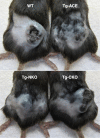Role of angiotensin-converting enzyme in myeloid cell immune responses
- PMID: 32508938
- PMCID: PMC7249647
- DOI: 10.1186/s11658-020-00225-w
Role of angiotensin-converting enzyme in myeloid cell immune responses
Abstract
Angiotensin-converting enzyme (ACE), a dicarboxypeptidase, plays a major role in the regulation of blood pressure by cleaving angiotensin I into angiotensin II (Ang II), a potent vasoconstrictor. Because of its wide substrate specificity and tissue distribution, ACE affects many diverse biological processes. In inflammatory diseases, including granuloma, atherosclerosis, chronic kidney disease and bacterial infection, ACE expression gets upregulated in immune cells, especially in myeloid cells. With increasing evidences connecting ACE functions to the pathogenesis of these acquired diseases, it is suggested that ACE plays a vital role in immune functions. Recent studies with mouse models of bacterial infection and tumor suggest that ACE plays an important role in the immune responses of myeloid cells. Inhibition of ACE suppresses neutrophil immune response to bacterial infection. In contrast, ACE overexpression in myeloid cells strongly induced bacterial and tumor resistance in mice. A detailed biochemical understanding of how ACE activates myeloid cells and which ACE peptide(s) (substrate or product) mediate these effects could lead to the development of novel therapies for boosting immunity against a variety of stimuli, including bacterial infection and tumor.
Keywords: Angiotensin-converting enzyme; Dendritic cells; Hematopoiesis; Immune response; MHC class I antigen presentation; Macrophages; Melanoma; Methicillin-resistant Staphylococcus aureus (MRSA); Myeloid cells; Neutrophils.
© The Author(s) 2020.
Conflict of interest statement
Competing interestsNo conflicts of interest, financial or otherwise, are declared by the authors.
Figures



References
Publication types
MeSH terms
Substances
Grants and funding
LinkOut - more resources
Full Text Sources
Research Materials
Miscellaneous

